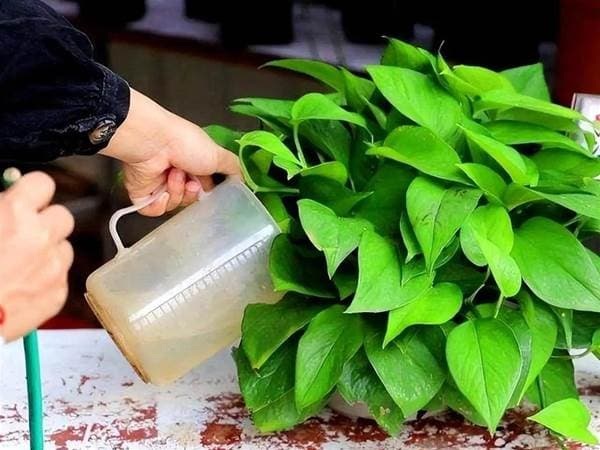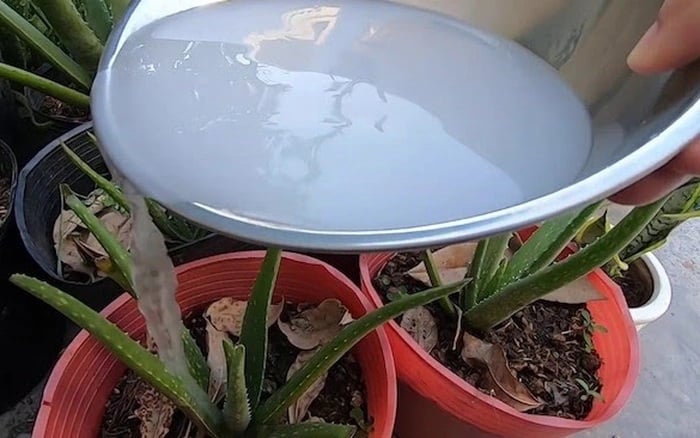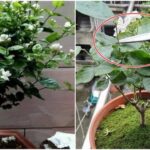1. Using Aquarium Water to Irrigate Houseplants
If you’re new to houseplants or unfamiliar with the best types of water to use for your plants, you might find this suggestion of mine rather silly. But for those who have years of experience in growing houseplants, this is a “miracle” solution for your green friends.

The Best Type of Water for Houseplants
You may not know this, but aquarium water is an excellent fertilizer for houseplants. Not only does it provide regular water, but the fish also produce fish waste over time, which is a great nutrient for your plants. This method will help your houseplants flourish and bloom beautifully throughout the year while saving you money on fertilizer.
Using aquarium water to irrigate your houseplants can provide the necessary nutrients for their growth. It will make your potted plants thrive, with lush green leaves, and promote faster blooming.
2. Using Rainwater for Irrigation
If using aquarium water is considered eccentric by some, then rainwater – a natural water source absorbed from rivers, lakes, and ponds – has been a familiar irrigation method for our ancestors since ancient times.
Rainwater contains many trace elements and is free of impurities, benefiting the root growth and blooming of houseplants. These roots and flowers will thrive with proper care.
You can collect and store rainwater for daily irrigation, which is both convenient and economical. Rainwater has a mild acidic property and also prevents soil compaction. However, when storing rainwater, use containers with lids to prevent mosquito larvae from breeding.
3. Using Leftover Tea Water
It is a long-standing tradition in Vietnam to welcome guests with a pot of tea. However, we don’t always finish the tea, and instead of discarding the leftover tea, why not use it to water your houseplants? It’s an excellent idea, isn’t it?
You can use fermented leftover tea water to maintain soil moisture and provide rich elements such as calcium, phosphorus, and potassium. This type of water is very suitable for flowering houseplants such as Cape jasmine, azaleas, milan, camellia, and jasmine.
Keep the leftover tea water and dilute it at a ratio of 1:10 to water your houseplants every morning. Do this consistently about 2-3 times a week, and you’ll see the difference.
Tea water is especially suitable for indoor and potted plants. However, we should only use fresh tea from the same day, as tea left overnight or stale tea has increased alkalinity, which is not good for plants.
Instead of discarding used tea leaves, you can also use them as fertilizer for your plants, which is very beneficial!

5 Types of Wastewater That Are Great for Irrigation
4. Using Egg Boiling Water
After boiling eggs, almost everyone tends to discard the water without realizing that it is considered a “miracle” liquid for watering houseplants.
Eggs are relatively nutritious, and some natural nutrients remain in the water during the boiling process, such as minerals. Using egg boiling water for flowering plants can make them bloom profusely and beautifully.
Water from boiling chicken or duck eggs contains 95% calcium carbonate. This substance will help flowers bloom beautifully and last longer, making it suitable for ornamental plants like roses, orchids, hydrangeas, or begonia. Regular use will prevent malnutrition and stunted growth in your houseplants.
Once the egg boiling water has cooled, you can directly water your plants or spray it on the leaves. Give it a try, and you’ll be surprised by the noticeable difference in your houseplants’ health and appearance.
5. Using Rice Washing Water for Plants
Rice washing water is readily available whenever you cook rice, so don’t throw it away! This water is excellent for watering plants during their growth and blooming seasons, spring and autumn. You can use it for larger pots during these seasons.
“The Secret to Year-Round Blooming Jasmine: A Magical ‘Stinky’ Water Solution”
For those seeking to enhance the beauty and fragrance of their jasmine flowers, these gardening enthusiasts offer a unique tip. They suggest that by watering your plants with a special “stinky water” concoction, you can encourage a hundred large, vibrant blooms, each more exquisite than the last, and all while intensifying the scent of your jasmine.






































